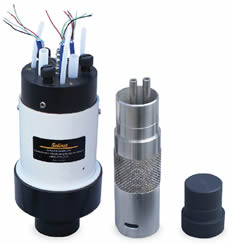

401 Waterloo Multilevel System uses modular components of various casing lengths, 316 stainless steel sampling ports, and packers. The engineered components are pushed together to form a reliably sealed casing string. Pumps and/or transducers can be dedicated to each port at each sampling zone. Open tubes can also be used to monitor each port. All instrument tubing and cabling is contained within these modules and collected at the top of the system at a wellhead manifold.
Based on borehole logs, Waterloo Systems can be customized for each site. The number of monitoring zones depends on the sampling and monitoring options chosen, and the number of cables and tubes that can fit in the well casing. Systems can monitor from 2 to 24 depth-discrete zones in one well.
Systems have been installed in overburden and bedrock applications up to 1000 ft. (300 m). Typical Systems use 2" (20 mm) Sch. 80 PVC casing that fits in 3-4" (75 - 100 mm) boreholes and 3 ft. (915 mm) long packers. The sampling ports are made from 316 stainless steel, with dual and single stem options.


Waterloo System in Bedrock
Using Permanent Packers
The ports can be fitted with dedicated bladder pumps or double valve pumps, pressure transducers, or both on a dual port. Dedicated equipment allows for fast and efficient monitoring, as decontamination requirements are eliminated and sampling times reduced. Dedicating equipment is ideal for long-term monitoring.
Ports fitted with open tubes can be monitored using small diameter portable equipment, such as Solinst Model 102 Water Level Meters, Model 410 Peristaltic Pump, or Model 408M Micro Double Valve Pump.
Compared to conventional monitoring wells, Waterloo Systems have many advantages:
- Fewer holes to drill for multiple depth-discrete monitoring zones
- Less site disturbance
- Less purge water to deal with when sampling
- Reduced project costs with quick sampling times
- Transects of Multilevels provide the high resolution data needed to calculate mass flux and estimate risks to receptors at contaminated sites
Patented.
